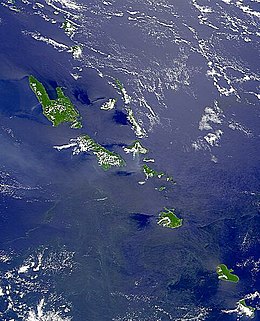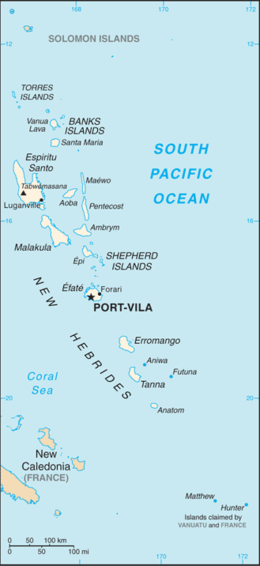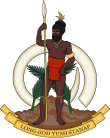| This article needs additional citations for verification. Please help improve this article by adding citations to reliable sources. Unsourced material may be challenged and removed. Find sources: "Geography of Vanuatu" – news · newspapers · books · scholar · JSTOR (January 2021) (Learn how and when to remove this message) |
 | |
| Region | Pacific Ocean |
|---|---|
| Coordinates | 16°00′S 167°00′E / 16.000°S 167.000°E / -16.000; 167.000 |
| Area | Ranked 157th |
| • Total | 12,189 km (4,706 sq mi) |
| • Land | 100% |
| • Water | 0% |
| Coastline | 2,528 km (1,571 mi) |
| Borders | None |
| Highest point | Mount Tabwemasana 1,877 metres (6,158 ft) |
| Lowest point | Pacific Ocean 0 metres (0 ft) |
| Exclusive economic zone | 663,251 km (256,083 sq mi) |

Vanuatu (formerly called the New Hebrides) is a nation and group of islands in the South Pacific Ocean. It is composed of over 80 islands with 2,528 kilometres (1,571 mi) of coastline and a total surface area of 12,189 square kilometres (4,706 sq mi). It's a small country with a total size of 12,189 km (4,706 sq mi). Due to the spread out islands it has the 39th largest Exclusive Economic Zone of 663,251 km (256,083 sq mi).
Vanuatu's geographic coordinates are 16°00′S 167°00′E / 16.000°S 167.000°E / -16.000; 167.000. It is part of Oceania. Its immediate neighbours include the Solomon Islands and New Caledonia, and Australia is the closest continent.
Terrain
Vanuatu is a mountainous archipelago of volcanic origin with narrow coastal plains.
The highest of all the mountains is Mount Tabwemasana at 1,877 metres (6,158 ft). Its tropical climate is moderated by southeast trade winds, and its natural resources include, hardwood forests, and fish. As of 2011, 1.64% of its land area is arable, 10.25% is devoted to crops, and a further 88.11% to other land usage.
Natural disasters include tropical cyclones or typhoons from January to April and volcanic activity which sometimes causes minor earthquakes. Tsunamis are also a hazard.
A majority of the population does not have access to a potable and reliable supply of water. Deforestation is another major concern on the islands.
Vanuatu is party to a number of international agreements, including agreements on Antarctic-Marine Living Resources, Biodiversity, Climate Change, Climate Change-Kyoto Protocol, Desertification, Endangered Species, Law of the Sea, Marine Dumping, Ozone Layer Protection, Ship Pollution, and Tropical Timber 94.
Closely tied to the Law of the Sea, Vanuatu lays maritime claim to 24 nautical miles (nm) of contiguous zone, 12 nm of territorial sea, and 200 nm of continental shelf and exclusive economic zone.
Climate
Vanuatu has a tropical climate, more specifically a tropical rainforest climate (Af in the Köppen climate classification), with noticeably wetter and drier months and hot, humid conditions year-round.. As the trade winds are almost permanent and tropical cyclones are not rare in Port Vila and Vanuatu, the climate is not equatorial but a maritime trade-wind tropical climate.
Vanuatu can be affected by tropical cyclones. Cyclone Pam was one of the worst cyclones to ever hit Vanuatu, and had been described as a worst-case scenario for the country, with the estimated cost of damage being in the hundreds of millions. In 2020, Cyclone Harold caused severe damage to Vanuatu and other Pacific nations.
| Climate data for Port Vila (Köppen Af) | |||||||||||||
|---|---|---|---|---|---|---|---|---|---|---|---|---|---|
| Month | Jan | Feb | Mar | Apr | May | Jun | Jul | Aug | Sep | Oct | Nov | Dec | Year |
| Record high °C (°F) | 35.0 (95.0) |
33.9 (93.0) |
33.5 (92.3) |
32.5 (90.5) |
31.1 (88.0) |
32.0 (89.6) |
34.3 (93.7) |
32.0 (89.6) |
31.5 (88.7) |
31.2 (88.2) |
33.0 (91.4) |
35.6 (96.1) |
35.6 (96.1) |
| Mean daily maximum °C (°F) | 31.3 (88.3) |
31.2 (88.2) |
30.8 (87.4) |
29.9 (85.8) |
28.8 (83.8) |
27.4 (81.3) |
26.4 (79.5) |
27.0 (80.6) |
27.7 (81.9) |
28.5 (83.3) |
29.2 (84.6) |
30.7 (87.3) |
29.1 (84.4) |
| Daily mean °C (°F) | 26.4 (79.5) |
26.5 (79.7) |
26.3 (79.3) |
25.3 (77.5) |
24.1 (75.4) |
23.0 (73.4) |
22.1 (71.8) |
22.0 (71.6) |
22.7 (72.9) |
23.4 (74.1) |
24.6 (76.3) |
25.7 (78.3) |
24.3 (75.7) |
| Mean daily minimum °C (°F) | 22.5 (72.5) |
23.0 (73.4) |
22.6 (72.7) |
22.0 (71.6) |
20.2 (68.4) |
19.8 (67.6) |
18.2 (64.8) |
18.0 (64.4) |
18.4 (65.1) |
19.6 (67.3) |
20.7 (69.3) |
21.7 (71.1) |
20.5 (68.9) |
| Record low °C (°F) | 15.8 (60.4) |
15.0 (59.0) |
16.3 (61.3) |
14.5 (58.1) |
13.4 (56.1) |
10.0 (50.0) |
8.5 (47.3) |
10.0 (50.0) |
9.9 (49.8) |
11.0 (51.8) |
12.6 (54.7) |
15.2 (59.4) |
8.5 (47.3) |
| Average rainfall mm (inches) | 316.1 (12.44) |
273.7 (10.78) |
320.9 (12.63) |
255.2 (10.05) |
210.3 (8.28) |
180.0 (7.09) |
94.4 (3.72) |
87.4 (3.44) |
87.3 (3.44) |
134.1 (5.28) |
192.3 (7.57) |
187.2 (7.37) |
2,338.9 (92.09) |
| Average rainy days (≥ 1.0 mm) | 15.4 | 16.6 | 18.5 | 17.1 | 12.9 | 11.3 | 10.3 | 9.8 | 8.1 | 8.4 | 12.1 | 13.2 | 153.7 |
| Average relative humidity (%) | 84 | 85 | 86 | 87 | 85 | 85 | 83 | 82 | 80 | 81 | 82 | 83 | 84 |
| Average dew point °C (°F) | 24 (75) |
24 (75) |
24 (75) |
23 (73) |
21 (70) |
21 (70) |
20 (68) |
20 (68) |
20 (68) |
21 (70) |
22 (72) |
23 (73) |
22 (71) |
| Mean monthly sunshine hours | 220.1 | 155.4 | 198.4 | 165.0 | 170.5 | 162.0 | 148.8 | 167.4 | 174.0 | 198.4 | 180.0 | 195.3 | 2,135.3 |
| Mean daily sunshine hours | 7.1 | 5.5 | 6.4 | 5.5 | 5.5 | 5.4 | 4.8 | 5.4 | 5.8 | 6.4 | 6.0 | 6.3 | 5.8 |
| Source 1: Deutscher Wetterdienst | |||||||||||||
| Source 2: Time and Date (dewpoints, between 2005-2015) | |||||||||||||
References
- "Australia - Oceania :: Vanuatu — The World Factbook - Central Intelligence Agency". www.cia.gov. Retrieved 2019-04-05.
- "Climatologie" by Pierre Estienne and Alain Godard, Éditions Armand Colin (ISBN 2-200-31042-0), "CHAPITRE XVI 1. Les climats équatoriaux et subéquatoriaux 2. Les climats tropicaux 3. Les climats d'alizé 4. Les climats de montagne LES CLIMATS DE LA ZONE INTERTROPICALE : LES VARIÉTÉS", pages 314, 315 and 322.
- "Vanuatu – Cyclone Pam Emergency Appeal". Unicef NZ. Archived from the original on 3 April 2015. Retrieved 16 March 2015.
- "Emergency – Cyclone Pam, Vanuatu". World Food Programme. ReliefWeb. 14 March 2015. Retrieved 15 March 2015.
- "Cyclone Pam: Vanuatu islanders forced to drink saltwater". British Broadcasting Company. 17 March 2015. Retrieved 17 March 2015.
- Steve Almasy and Jethro Mullen (15 March 2015). "Aid workers scramble to help Cyclone Pam victims in Vanuatu". CNN. Retrieved 15 March 2015.
- "UNESCO supports recovery of Vanuatu's culture sector following Tropical Cyclone Pam". Prevention Web. 15 May 2015. Archived from the original on 2 October 2015. Retrieved 2 July 2015.
- "Vanuatu braces for strengthening tropical cyclone Harold". SBS News. SBS. April 6, 2020. Retrieved April 6, 2020.
- Cappucci, Matthew (April 7, 2020). "Tropical Cyclone Harold rakes Fiji after slamming Vanuatu at Category 5 strength". The Washington Post. Washington, D.C. Retrieved April 7, 2020.
- Vanuatu, ) in (April 6, 2020). "#CycloneHarold #TCHarold #Vanuatu @UNICEFPacific declares that 100,000 people have been impacted, a third of the country's population, the majority of whom are children. Widespread network outages is hindering news from affected areas". @sandravanuatu. Retrieved April 7, 2020.
- "Casualties reported in Vanuatu following TC Harold". RNZ. Radio New Zealand. April 9, 2020. Retrieved April 10, 2020.
- "Klimatafel von Vila (Int. Flugh.) / Insel Efaté / Vanuatu (Neue Hebriden)" (PDF). Baseline climate means (1961-1990) from stations all over the world (in German). Deutscher Wetterdienst. March 2014. Archived from the original (PDF) on 10 May 2017. Retrieved 22 November 2016.
- "Climate & Weather Averages at Bauerfield Efate weather station (91557)". Time and Date. Retrieved 6 February 2022.
| Vanuatu articles | |||||
|---|---|---|---|---|---|
| History |  | ||||
| Geography | |||||
| Politics | |||||
| Economy | |||||
| Society |
| ||||
| Geography of Oceania | |
|---|---|
| Sovereign states | |
| Associated states of New Zealand | |
| Dependencies and other territories | |
![]() This article incorporates public domain material from The World Factbook. CIA.
This article incorporates public domain material from The World Factbook. CIA.

